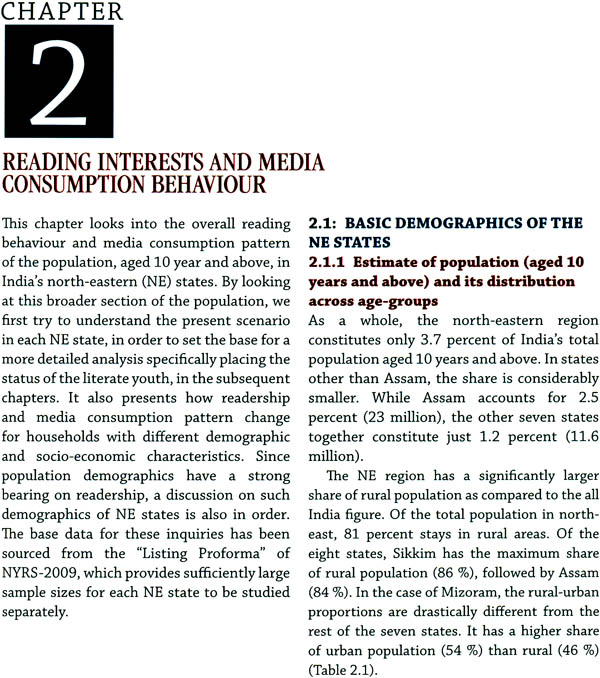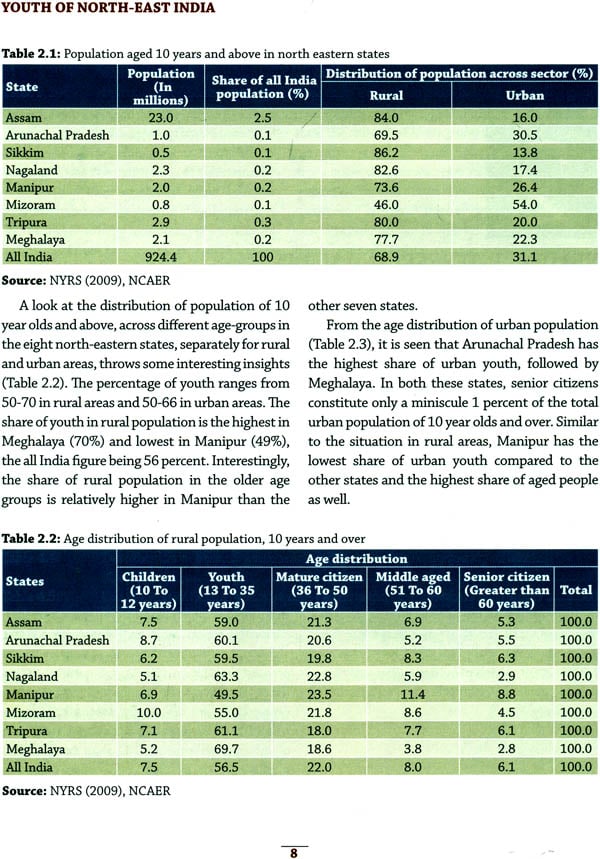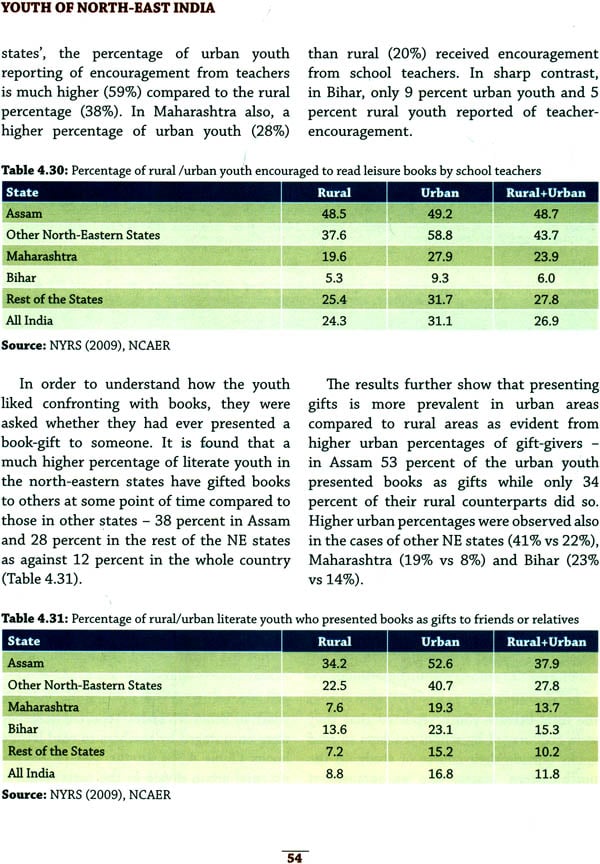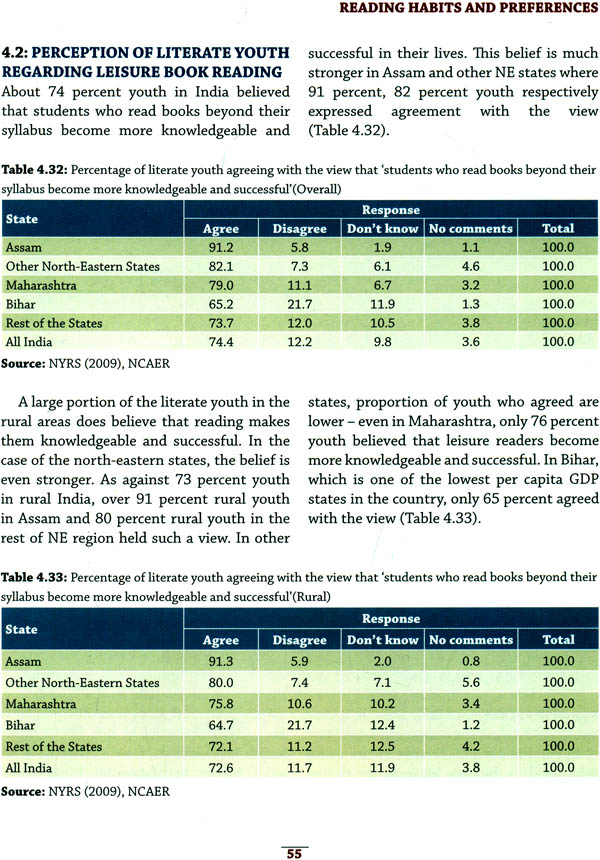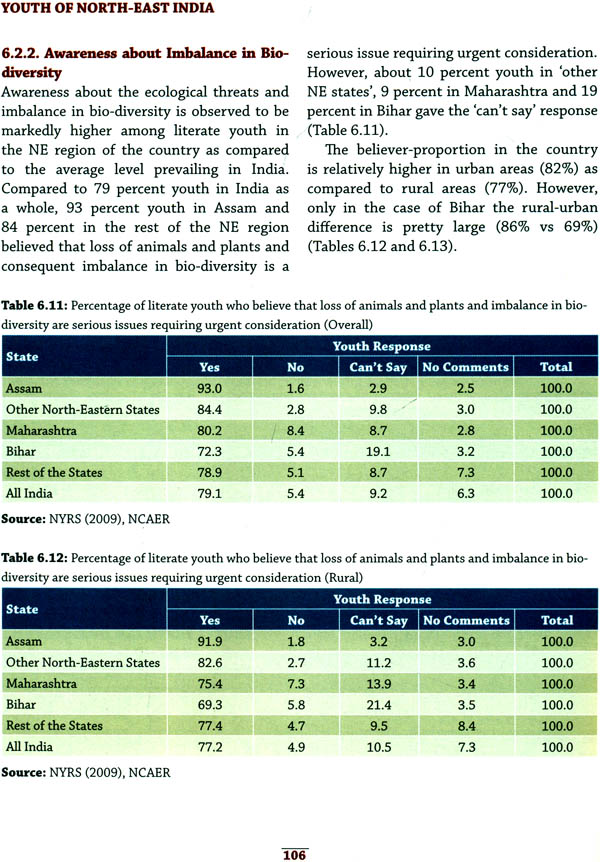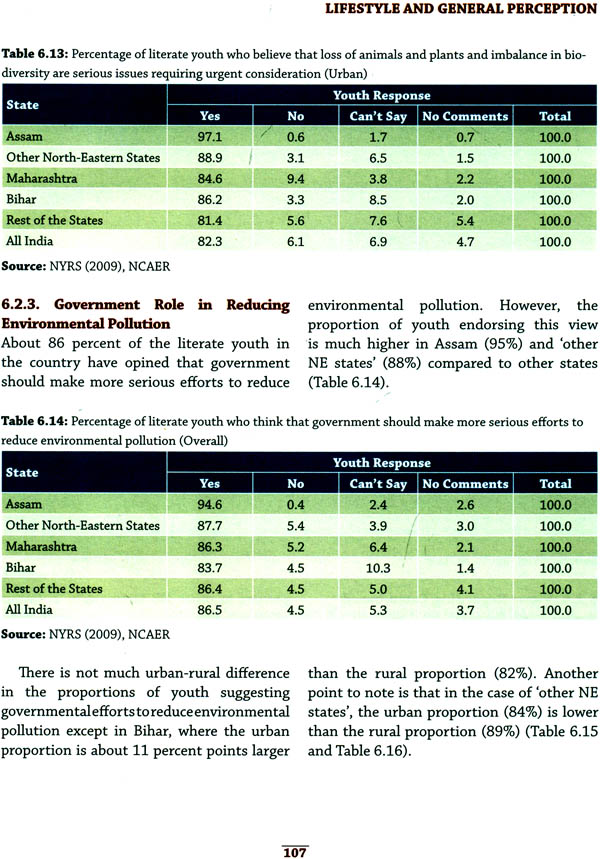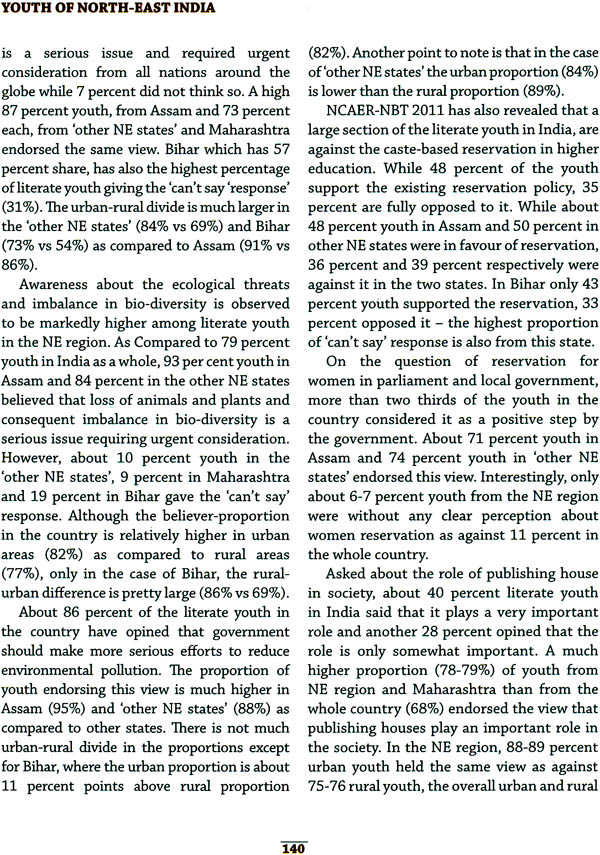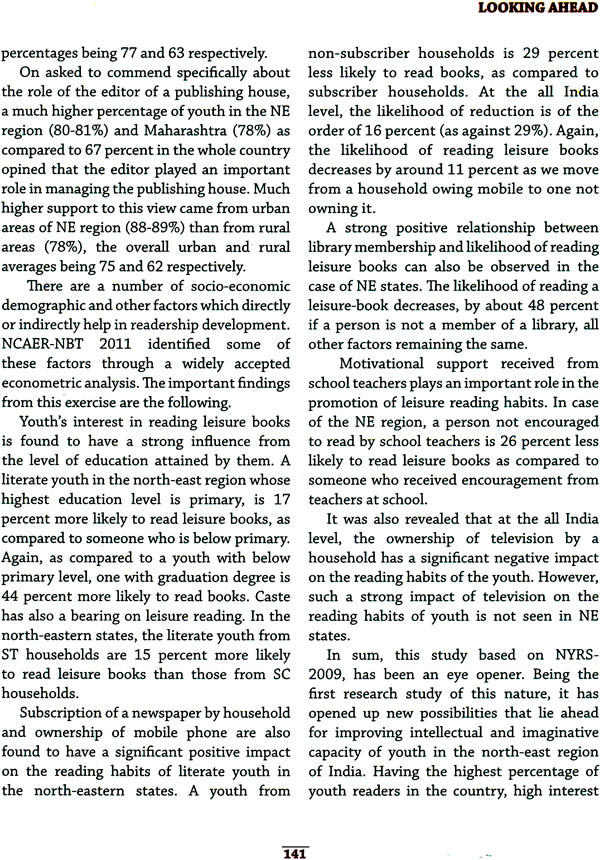
Youth of North- East India (Demographics and Readership)
Book Specification
| Item Code: | NAI450 |
| Publisher: | National Book Trust, India |
| Language: | English |
| Edition: | 2012 |
| ISBN: | 9788123765525 |
| Pages: | 178 |
| Cover: | Hardcover |
| Other Details | 10 inch X 7.5 inch |
| Weight | 750 gm |
Book Description
National Book Trust, India (NBT)
National Book Trust, India, an autonomous organization under the Ministry of Human Resource Development, Government of India, was established in 1957 with the twin purpose of book publishing and book promotion in the country with the objective to create a culture of reading and book mindedness in the society. The major activities of the Trust are publishing in nearly 30 Indian languages including English under some well-defined series for children, young as well as general adult readers, promotion of books and reading, organising book festivals, fairs and exhibitions including its immensely popular 'Mobile Book Exhibitions', running book clubs, publishing courses, promotion of Indian books abroad, promotion of children's literature, assistance to authors and publishers in the form of subsidies and grants, organizing the biennial New Delhi World Book Fairs, which have now become annual from 2013.
National Book Trust, India will make available books recognised to be good at a low cost and create a climate for book reading and book buying among the vast number of people in the country ... It will also serve as a kind of 'book hospital' for finding out what generally stood in the way of books being purchased and read.
National Council of Applied Economic Research (NCAER)
NCAER was established in 1956 as a registered society. As a premier applied economics research institute in the country, NCAER is committed to enhance public awareness of policy issues in business and economics and to facilitate solutions that will contribute to overall national development. By publishing the findings of its research, and through the active participation of its senior researchers in media and policy, it aims to bring new knowledge to attention of policy makers.
The National Youth Readership Survey (NYRS) was conducted by National Council of Applied Economic Research on behalf of the National Book Trust, India at the all India level with the objective to get a clear understanding of the present scenario of readership and media consumption behaviour of the literate youth in India in a comprehensive manner under the National Action Plan for the Readership Development Among the Youth (NAPRDY) mooted by the Trust. The present report, as a follow up of the NYRS, which was published in 2010, attempts to give a detailed account of the reading habits of the literate youth in the north eastern states and their exposure to different forms of media, and how diverse socio economic and motivational factors impact their reading habit. In order to have a better understanding of the status of the North Eastern (NE) states as compared to the rest of country, the findings are compared with the similar result for one rich state (Maharashtra) and one economically backward state (Bihar) of India chosen on the basis of their per capita gross domestic product. This is over and above the comparison of the findings in respect of the NE states with the overall Indian situation.
1.1 THE NORTH-EAST REGION AND ITS UNIQUENESS
The north-eastern region of India or the north- east (NE), as it is popularly known, comprises of eight states namely, Assam, Arunachal Pradesh, Manipur, Meghalaya, Mizoram, Nagaland, Sikkim and Tripura. Among the north-eastern states, Sikkim became an Indian protectorate in the year 1947 and a full state in 1975. The "Siliguri" corridor of West Bengal connects the north eastern region with the rest of India. More than 2000 km of boundary of this region is shared with other countries, which include Nepal, China, Bhutan, Burma and Bangladesh. With a population of 31.2 million in the year 2011, Assam is the biggest state in the north-eastern region, while the rest of the states are much smaller in terms of population size. Assam is followed by Tripura with a population of 3.7 million, whereas Sikkim has the lowest population of 0.6 million. It is interesting to observe that apart from Arunachal Pradesh and Nagaland, the other six north-eastern states have sex ratios that are considerably higher than all India average. In terms of geographical spread of areas, Arunachal Pradesh is the largest among the eight states.
What is so unique about the north-east that qualifies it as a region that calls for special focus and that makes it distinctive enough to be studied as a separate region? Apart from geographical location, this region is different from the rest of the country because of many other characteristics, of which a few important ones are as follows:
• The north-east has a rich base of natural resources, the most important ones being tea and crude oil. India is the world's largest tea producer and Assam is one of the main tea growing regions in India, producing both mass-market tea, and premium specialty or orthodox teas. The tea growing region of Assam lies at the foothills of the eastern Himalayas in the far north-eastern corner of India. The north-east region, especially Assam, has been bestowed with abundant crude oil and natural gas reserves. Assam accounts for about 15 percent of India's crude output and produces natural gas equaling about 50 percent of India's total onshore production. Another important advantage of the north-east is that it has a rich forest cover. Roughly half of the forests are reserved. Blessed with plentiful rainfall, the forests are a reserve of commercially useful produce such as timber, bamboo, stone, and cane. Bamboo is the best natural engineering material on this planet. India's 64 percent and world's 20 percent growing stock of bamboo grows in NE India.
• The north-east has its own distinctive environmental beauty and elegance. Most parts of the north-east are hilly and have plains on both sides of the river Brahmaputra, and are surrounded by the Himalayan ranges. Assam occupies the lush lowlands of the Brahmaputra valley. Arunachal Pradesh occupies the densely forested and sparsely populated foothills of the Himalayas, and is one of the major tourist attractions. Meghalaya, with its pine clad hills and lakes, is famous as the wettest region of the world. The other three states -Manipur, Mizoram and Tripura - make up a fascinating area consisting of green valleys, lush hills with variety of flora and fauna. Its natural landscape, lush green forests, wild life sanctuaries, pilgrimage spots and tea gardens offer a wide choice to cater to the tastes of a variety of tourists with different interests.
• The pace of economic development in the hilly areas of the region differs considerably from the plains. The valleys are economically active areas of the region, the Brahmaputra valley being the most active. There are differences among the eight states of the region with respect to their resource endowments, level of industrialisation as well as infrastructural facilities. Despite being rich in natural resources, the overall economic development in the North Eastern region has been lagging behind the rest of the country. The region's economy is generally characterized by low per-capita income, in-adequate infrastructure facilities, geographical isolation, inadequate exploitation of natural resources such as minerals, hydro power potential, and forests, and comparatively high un-employment rate among the literate population.
• The pace of economic development in the hilly areas of the region differs considerably from the plains. The valleys are economically active areas of the region, the Brahmaputra valley being the most active. There are differences among the eight states of the region with respect to their resource endowments, level of industrialisation as well as infrastructural facilities. Despite being rich in natural resources, the overall economic development in the North Eastern region has been lagging behind the rest of the country. The region's economy is generally characterized by low per- capita income, in-adequate infrastructure facilities, geographical isolation, inadequate exploitation of natural resources such as minerals, hydro power potential, and forests, and comparatively high un- employment rate among the literate population.
1.2 BACKGROUND OF THE STUDY
"Youth bulge" is a situation where a large proportion of young people reach productive age due to transition from high to low fertility, and the proportion of children and the elderly remains small. It is seen as an advantage, even characterised as a "demographic dividend". By 2020, an average Indian is expected to be only 29 years old, as against 37 in China and the United States. His counterpart in Western Europe would be 45 and the average Japanese, 48 years old. Youth (the population in 13 - 35 years age group) have specific socio- economic needs and play an important role in determining the future trend of economic development of any region. Therefore, it becomes extremely important to provide them with adequate educational facilities as well as income-earning opportunities. However, along with formal education, another equally important aspect for all-round development of youth is knowledge about different aspects of society and life, and expansion of their imaginative power. In order to achieve that, it is essential to inculcate reading habits in the youth and expose them to different forms of media. Books, magazines, and newspapers - in short, the printed word - has historically been one of the most important inputs for any society's intellectual progression. There is little point in expending government resources in spreading literacy if there is no follow-up programme to inculcate the reading habit. The creation of a reading culture and the promotion of reading among youngsters are fundamental for achieving the conceptual quotient of education. However, there is not much information available that reflects what the present readership behaviour and media consumption pattern among the youth in India are. At the same time, there has been hardly any all India level surveyor research study that has attempted to cover this aspect of youth in India. In order to fill this gap, the National Youth Readership Survey (NYRS) was conducted by National Council of Applied Economic Research (NCAER) during 2009 on behalf of the National Book Trust (NBT), India at the all India level with the objective to get a clear understanding of the present scenario of readership and media consumption behaviour of youth in India in a comprehensive manner.
As in other parts of the country, youth constitutes a dominant share of the population in the north-eastern region as well. In some of these states, more than half of the population comprises of youth. This report, as a follow up of the NYRS, attempts to give a detailed account of the reading habits of the literate youth in the north-eastern states and their exposure to different forms of media, and how different socio-economic and motivational factors impact the reading habits. But what is so exceptional and special about the readership and media consumption pattern in the north- east region, that makes it important enough to be studied exclusively as a separate region? The All India report! that was published in 2010 based on the NYRS-2009 results, gave enough indications about the uniqueness and distinctive features of readership and media usage by youth of this region as compared to the other parts of the country. This prompted the NBT to assign another study to have a deeper understanding of the reading habits and media consumption pattern of the north- eastern states. Some of the distinctive features of the north-east region based on the all India study are summarised below:
The north-eastern states of India, despite their economic backwardness, have a greater proportion of readers among its youth population. The survey results reveal that in the north-eastern states, 43 percent of the youth are readers. While the central states have the largest block (85%) of non-readers, the north-east has the smallest (57%).
It is noticed that the north-eastern region has the highest proportion of literate youth hailing from rural areas, while in the remaining parts of India, the concentration of literate youth is more towards urban.
As compared to the all India average of 7.3 percent, a much higher percentage of literate youth in rural areas of north-east are working as self-employed in non-agriculture activities (12% to 14%). However, those who work as regular salaried or wage earners are relatively smaller. This is also true for urban areas of the region.
Even though, in the northern, eastern and north-eastern states, the general castes' literate youths dominate, it may be pointed out that the north-east is home to a relatively higher proportion (23%) of the literate youth from Scheduled Tribe (ST) community. Moreover, a relatively higher concentration of Muslim literate youth is noticed in the north-eastern states since about one-third of the literate youth in this region are Muslims, followed by another 18 percent Christians.
• After south India, the north-east has the maximum percentage of literate youth who are members of a library.
National Book Trust, India was established in 1957 by our first Prime Minister Shri Jawaharlal Nehru as part of the mammoth nation building exercise that was taken up immediately after the independence in the social, political, economic and cultural fields. The idea was to create a funded institution that could create good books, make them available to the general readers at the affordable prices and which would keep finding ways to understand and meet the reading needs of the masses at large.
I think that of all the institutions that were founded to work in the cultural fields, the founding of an institution like National Book Trust, India for creating learning and book reading society was the most visionary one. It is so, because, while most of the institutions had a clear cut target area like working for the theatres, arts, literature etc. NBT, India was asked to work for the readings needs of the general masses. With less than one third of the population literate at the time of India's independence , to be able to visualize a society that needed to be nourished on progressive and secular books to understand and sustain the basic foundations of the independent India was a masterstroke. The Trust has played a vital role in providing quality books to all target audience including children since its inceptions.
In the light of the growing importance of the youth in the affairs of the country, the Trust took an initiative to frame a National Action Plan for the Readership Development among the Youth (NAPRDY) and entrusted the job of undertaking the National Youth Readership Survey from the perspective of book reading habit to the National Council of Applied Economic Research (NCAER), probably one of the best in the world to conduct such surveys and analyses. The findings there-from injected new dynamism into the country's data base on this largest segment of its population-youth. Moreover, interesting revelations on certain basic features of the youth population in the North-eastern states of India prompted the NBT to approve the present investigation on reading habits and media consumption behaviour with special reference to the NE States.
I am happy to note that the relevant data and statistics from the North-East states have been correlated with those from Maharashtra, the state with the highest per capita income, and from Bihar, the state with lowest per capita income, for deeper and wider understanding of the issues pertaining to the reading habit of the literate youth in the specific context of the North-East of India. I believe that the findings of the investigation will open up new windows to the understanding of the way this important segment of our population in this region thinks and behaves when it comes to books and readings culture.
This readership study on India's North-Eastern states is a follow up to the previous work by the National Council of Applied Economic Research (NCAER) on a National Youth Readership Survey in 2010. The North-East is one of the most diverse regions in the country and has distinct cultures and traditions. The region has been a meeting point for many communities, faiths, and cultures and is home to a diverse group of people speaking a wide range of languages. Some groups have migrated over the centuries from places as far as South East Asia. The range of communities and geographical and ecological diversity makes this region a unique place compared to the other parts of this subcontinent.
The primary objective of this study was to assess the readership and media usage patterns among literate youth in the North-Eastern states. The study looks into their basic demographic and socio-economic characteristics and seeks to identify how these factors impact the likelihood of reading leisure books. As compared to the rest of India, the North-Eastern states have a much higher readership of leisure books. The results reveal that the North-Eastern states, despite their economic backwardness in infrastructure and other indicators, have a greater proportion of readers in its youth population -43 percent as against an all-India average of 25 percent. Further, the North-Eastern region has the highest proportion of literate youth in rural areas, while in the rest of India the concentration of literate youth is in urban areas. The percentage of literate youth in rural areas of the North-East who are self-employed in non-agriculture activities is double that of the all-India average.
The development of reading habits among youth , its causes and primary influences are relatively unexplored areas of inquiry. This report is an attempt to fill this gap for the North-East States and understanding their substantially superior performance on reading. Developing a reading culture and creating adequate opportunities for reading are the foundations of rich intellectual and emotional lives and basis for sound citizenship values. These need to be nurtured continuously in schools and sustained later in through the conscious efforts of the public education system, libraries, and increasingly, access to the Internet. I am sure the results of this work sponsored by National Book Trust will form an important input for policy makers and stakeholders in further promoting reading habits among the youth of this region. The superior performance of the North-East sates in their incidence of youth readership should also provided lessons for the rest of India.
| Study Team | vii |
| Foreword | ix |
| Preface | xi |
| Acknowledgements | xiii |
| List of Tables | xv |
| List of Figures | xxiii |
| Chapter 1: Introduction | 1 |
| The North-East Region and Its Uniqueness | 1 |
| Background of the Study | 2 |
| Key Objectives | 4 |
| Structure of the Report | 6 |
| Chapter 2: Reading Interests and Media Consumption Behaviour | 7 |
| Estimate of Population (aged 10 years and above )and its Distribution Across Age-Groups | 7 |
| Distribution of Population (10 years and over) Across Education Levels | 9 |
| Leisure-Book Reading Among Literates (10 years and Over) | 10 |
| Newspaper Reading Among Literates (10 years and over) | 14 |
| Subscription to Newspapers and Magazines | 16 |
| Major Source of Information | 19 |
| Chapter 3: Demographic and Socio-Economic Characteristics of Literate Youth | 21 |
| Estimates of Literate Youth for Different North-Eastern States | 21 |
| Age Distribution of Literate Youth | 22 |
| Activity Status of Literate Youth | 23 |
| Educational Attainments of Youth in NE Region | 26 |
| Reasons for Discontinuing Studies by Literate Youth | 27 |
| Role of English language in Education and Employment | 30 |
| Whether the Literate Youth have a Relaxed Day-To-Day Life? | 32 |
| Employment in NE Region | 33 |
| Employment Rate in NE Region | 33 |
| Reasons for Unemployment Among Literate Youth | 34 |
| NREGA: A Social Security Scheme for the Rural Unemployed | 35 |
| Chapter 4: Reading Habits and Preferences | 37 |
| Higher Readership In North-Eastern States | 37 |
| Frequency of Reading Leisure Books | 38 |
| Time of Reading Leisure Books | 39 |
| Broad Genre of Books Read | 41 |
| Reading Enjoyment and Self-Rated Reading Skill of Literate Youth | 47 |
| Library Membership and Frequency of Library Visits | 49 |
| Factors Influencing Book Buying | 51 |
| Perception of Literate Youth Regarding Leisure Book Reading | 55 |
| Profile of Literate Youth and Readership | 62 |
| Factors Motivating the Youth to Read | 66 |
| Preferred Language for Reading Books | 71 |
| Chapter 5: Exposure of Literate Youth to Media and Reading Materials | 73 |
| Interest and Information Level of Literate Youth in Different Topics/Issues | 73 |
| Exposure of Literate Youth to Media | 81 |
| Chapter 6: Life Style and General Perception | 101 |
| Satisfaction from Overall Achievements in Life | 101 |
| Youth's Interest in Science | 102 |
| Youth's Interest in Medical Research | 103 |
| The Issue of Global Warming | 104 |
| Awareness about imbalance in Bio-diversity | 106 |
| Government's Role in Reducing Emvironmental Pollution | 107 |
| Views Regarding Caste-based Reservation Systems | 108 |
| Perception Regarding the Role of Publishing House in Society | 111 |
| Awarness about Government Schemes/Policies Towards Youth | 114 |
| Chapter 7: Likelihood of Leisure-Reading: Impact of Demographic and Socio-Economic Factors | 117 |
| Methodology | 117 |
| Findings of the Econometric Analysis | 119 |
| Chapter 8 : Looking Ahead | 125 |
| References | 143 |
| Appendix I: Glossary | 145 |
| Appendix II: Survey Methodology | 149 |
